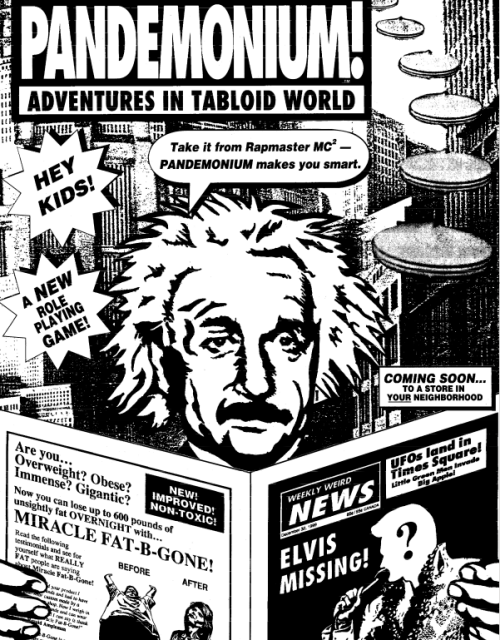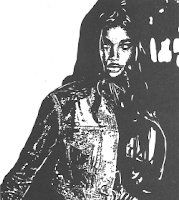 |
| Art by Janine Johnston |
Casting about for my next study after Tabloid! and Pandemonium!, I thought about Everway. It's not exactly old school, but it is twenty-five years old. Little did I realize a Kickstarter for a silver anniversary edition is planned for next month by the aptly named The Everway Company.
Designed by Jonathan Tweet, Everway was published by Wizards of the Coast as part of its Alter Ego line of role-playing games. Such a combination of designer and publisher might seem auspicious, but the game's success was rather equivocal. Everway was released in August 1995 and, four months later, WotC discontinued it's line of role-playing games. This seems like some sort of urgent, end-of-the-year budgetary action. (Yet sixteen months after that, WotC acquired the world's most popular role-playing game.)
Rumor has it that WotC required businesses that sold Magic: The Gathering to also sell Everway, forcing Everway into retail channels that did not want to accommodate role-playing games. A survey included with the game shows the types of establishments WotC thought would carry Everway.
Were there many “New Age” bookstores that sold Everway ? In any event, the suggested retail price for the Everway set was a pricey $35 (which would be approximately $60 in 2020 terms). The sizable box (9.5" × 13.5" × 2") included:
- Playing Guide (162 pages)
- Gamemastering Guide (64 pages)
- Guide to the Fortune Deck (14 pages)
- Fortune Deck (consisting of 36 cards)
- Vision Cards (90)
- Quest Cards (6)
- Source Cards (4)
- Blank Character Sheets (12)
- Character Sheets with Pre-Generated Characters (12)
- Maps (2)
Also included, but not listed on the back of the box, were the aforementioned survey and a plastic tray. The tray was able to hold all cards included in the game, as well as a set of “companion collector” vision cards (sold separately). Honestly, the large box didn't need to be so large. The guide books measure roughly roughly 7" × 9". The character sheets and maps are 8.5" × 11", but they could have been folded in half for the sake of a more compact box.
Not surprisingly, the company behind Magic: The Gathering made cards an essential part of their Everway role-playing game. Rather than dice, Everway employs a Fortune Deck to determine the outcome of actions in the game. Cards from the Fortune Deck have iconography similar to the Major Arcana of the tarot. (The survey asks, “Do you own tarot cards?” If so, “How many decks do you own? 1-2, 3-5, 6-10, Over 10”) Lacking numerical values, interpretation of the cards is necessarily subjective. Like tarot cards, a Fortune Deck card has both a normal meaning as well as a reversed meaning. For example, 'The Griffin' card has a normal meaning of “valor” and a reversed meaning of “cowardice.”
Each of the 'source cards' depicts an aspect of the Everway setting with a brief, informative paragraph on the back. Shown at the beginning of this post is the “Gate” source card.
The 'quest cards' depict aspects of the ready-to-run quest (i.e., introductory adventure) provided in the Gamemastering Guide. Five of the six cards are of non-player characters from that quest. This is helpful in showing players what these characters look like. The backs of the cards indicate the attributes of the characters, convenient for the gamemaster's reference.
The 'vision cards' distinguish Everway from other role-playing games, both then and now. These cards are instrumental in creating a character as well as recording the character's continuing, in-game story. Creating player characters begins with the Vision Stage, which requires vision cards. According to page 67 of the Playing Guide :
You use vision cards to develop your hero's background and identity. First, look over the vision cards. Your gamemaster may provide some, as may your fellow players and you may, of course, provide your own. Select five cards that attract you. You need not decide right away what these cards will mean to your hero.
When you have selected the cards to use, look them over and invent a hero and that hero's background. You only need a sketchy idea of your hero for now. You can write notes about your hero's background on the back of your hero sheet.
Keep your vision cards so that you can show them to other players. You may want to buy special sheets that hold, display, and protect cards like these. You will be getting more vision cards cards as your hero completes quests; your gamemaster gives these cards to you so you can have a visual record of your hero's activities.
A side bar informs us, “If the gamemaster provides your vision cards, be ready to give them back if you stop playing your hero.”
Each vision card has an image of a person or scene. The back of each card presents questions about the image that encourage interpretations that may be useful in establishing a character's background.
An important part of the Vision Stage is the “introduction,” wherein the players show one another the vision cards they selected for their respective characters and “describe briefly what these images mean.” Players question one another (as does the gamemaster) general questions about their characters. As I mentioned previously, this exercise enriches a player's concept of his or her character and allows players to appreciate one another's characters. In this manner, a player character becomes a genuine character as opposed to something that can be reduced to various numbers and a class affiliation. It is this sort of human interaction that can differentiate tabletop role-playing from computer role-playing.
A side bar on page 68 of the Playing Guide states:
If you develop a hero alone, leave some details unfinished. When you get a chance, have another player ask you questions about the hero so that you get some input from others before finalizing the hero... You can even talk with another player over the phone or email, though this prevents the other player from seeing your images.
Liberated from the technological restrictions of the 20th Century, sharing images is no longer an obstacle. In fact, nowadays, physical cards are unnecessary. An app would facilitate the Vision Stage.
As alluded to above, a separate set of ninety vision cards was available to enhance Everway play. The ninety cards included with the game should be sufficient for most playing groups, but surely additional options would be welcome. These “companion collector” vision cards were sold in booster packs. (Leave it to Wizards of the Coast to shoehorn aspects of a collectible card game into a role-playing game.) This gimmick may have put off gamers that may have otherwise shown an interest in Everway. Such booster packs may have been viable if – in addition to vision cards – they included more source cards, quest cards, and alternate versions of Fortune Deck cards; may have been viable, but probably not.

























